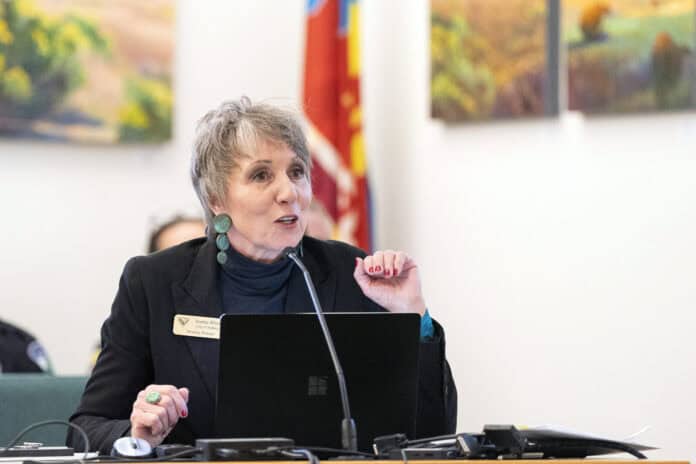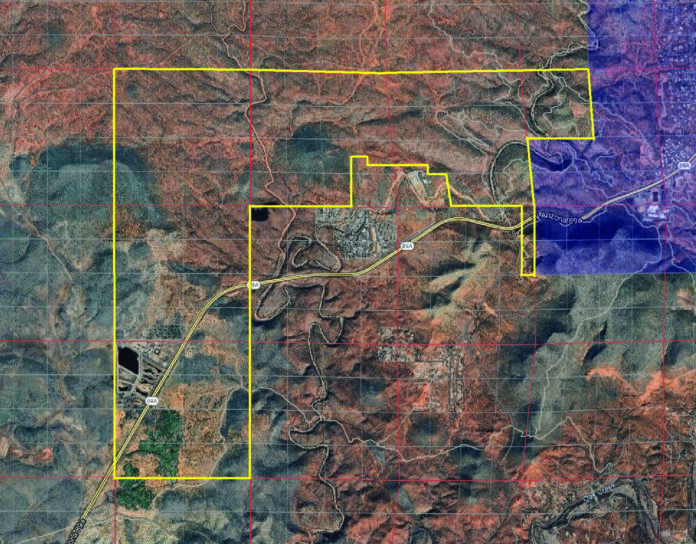City Council blocks private sport courts – Sedona Red Rock News

The Sedona City Council voted unanimously to approve an ordinance amending the Land Development Code to impose restrictions on the construction of new private sport courts during its April 22 meeting.
Noise
Council had previously directed staff to draft such an ordinance on Oct. 9 after hearing a series of complaints from residents of one neighborhood that the noise from a private pickleball court being constructed in that neighbor hood would be hazardous to their and their dogs’ health.
Planning Manager Cari Meyer informed council at that time that the city had no record of any noise complaints associated with the city’s 13 existing private sport courts.
Resident Becky Hofer said during the Oct. 9 hearing that pickleball play produced sound levels of 110 dB “at the paddle.”
Due to physics, the sound from a 110-dB pickleball strike diminishes to 60 dB, the city’s noise limit for residential areas, at 26.35 feet away from the paddle and to 50 dB at a distance of 85 feet. At a distance of 200 feet, a 110-dB noise would diminish to 42.4 dB, quieter than a refrigerator.
Definition
The amendments to the LDC would define a sport court as “any flat, hardscape area of dimensions exceeding 20 feet by 30 feet, specifically designed for athletic purposes, including, but not limited to, basketball courts, tennis courts, handball courts, racquetball courts and pickleball courts, but excluding pools and driveways used exclusively for access to a garage.”
A sport court would become a conditional accessory use on a property and require that such a court be set back at least 200 feet from any property line unless it met at least two of five criteria, in which case the setback could be reduced to 25 feet: Incorporated sound mitigation to reduce the sound from the court at the property line to less than 50 decibels; was located on a common piece of property for use by multiple owners; other property owners within 200 feet agreed to the reduced setback; was separated from the property line by buildings; or was surrounded by city or U.S. Forest Service property not capable of development.
The minimum size of a property that could contain a 20-by 30-foot court surrounded by 200-foot setbacks would be 4.15 acres, while the minimum size of a property to which 25-foot setbacks could apply would be 5,600 square feet.
A sport court must also be surrounded by a fence or wall and would not be allowed to be rented separately from the property. The use of sport courts before 8 a.m. or after 8 a.m. would also be banned, unless modified by a conditional use permit, and any lighting of courts on single-family proper ties would be prohibited.
The Planning and Zoning Commission previously approved the proposed LDC amendments by a 6-1 vote on March 18, with Commissioner Kali Gajewski voting against the ordinance on the grounds that it felt anti-family.
Conditional Use Permit
“It kind of looks like we’re setting the table for a group of people in an HOA to put a sports court next to a private residential home that’s not — and allow them to have a setback,” Councilman Pete Furman said with regard to the CUP provision.
“If it’s a group of property owners coming together and saying we want to build this, we felt that was a way to allow the HOAs to do it,” Meyer said.
“In a wrong-headed enforcement machine, which I don’t think we have now, the words exclusively used for access to a garage could turn bad,” Furman said. “If someone has a driveway that they start to play basketball in … there could be an interpretation that that driveway is no longer exclusively used for a garage.”
“The intent of it was to not allow someone to pave an extensive area and say this was all my driveway,” Meyer said. “I don’t see that in that ability,” City Attorney Kurt Christianson said.
Councilwoman Kathy Kinsella asked if the word “exclusively” could be removed from the ordinance language.
“That was a definition we found from another city, and it seemed like a definition that would work, so we used it,” Meyer said. “The intent was that people couldn’t just pave every thing and kind of connect it all and call it their driveway and get around the regulations.”
“I think it’s describing the access, not necessarily the use,” Christianson said.
Mayor Scott Jablow asked if the new rule could be used to prohibit courts on the remaining vacant lots in a subdivision near his house.
Becky Hofer, Bob Pifke and Norris Peterson supported the ordinance during the public comment period.
Council Comments
“I’m just still a little bit fuzzy on whether the CUP is a necessity or not,” Councilman Brian Fultz said.
“This could be us worrying about something when there could only be two sports courts in the next 10 years,” Councilwoman Melissa Dunn said, adding that while it might be “overly burdensome” to have the CUP applications sent to P&Z rather the community development department, staff would tell them if there was a problem.
“I don’t understand the CUP either. I think it’s unnecessary,” Vice Mayor Holli Ploog said. “It seems cumbersome to conduct a public hearing.”
“I’m in favor of the CUP process,” Councilman Derek Pfaff said. “These things prob ably don’t belong in residential neighborhoods, so if there’s a little bit of an extra burden that people have to go through in order to construct one, I’m fine with that.”
“I just don’t think it’s going to happen all that much,” Councilman Pete Furman said with regard to the CUP process, adding that he would trust staff’s interpretations of the language, but suggested that the city could have achieved “a much finer tuned solution” without an LDC change by modifying the noise and lighting ordinance. “We’re coming out a little bit unfriendly, perhaps, sounding to families and people that want to do things in their backyard.”
“I don’t think this would create an undue burden because we don’t expect that many of them,” Kinsella said.
“I trust the staff if it goes to staff instead of going to P&Z,” Jablow said.
The council then passed the ordinance unanimously. It will take effect on Thursday, May 22.



